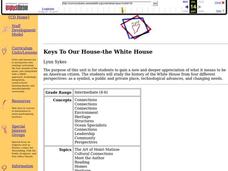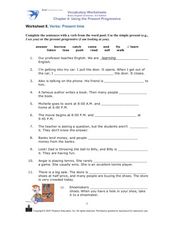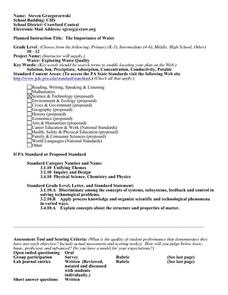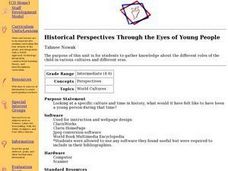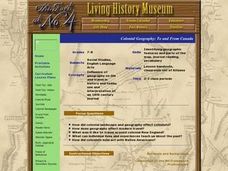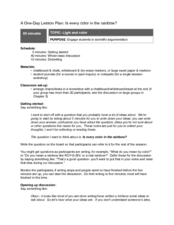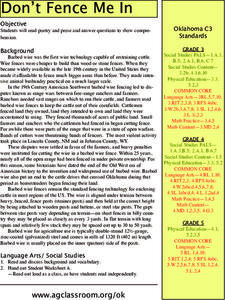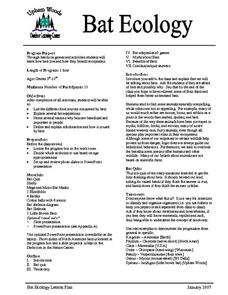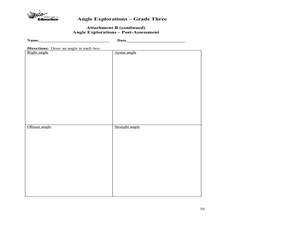Curated OER
The Dream Factory
Students compare postcard samples from Los Angeles, CA and Austin, TX. They examine them to find common elements they share (tone, mood, romanticized themes, artistic elements, etc.) They create postcards to show the "real" Austin.
Curated OER
"Shooting An Elephant": George Orwell's Essay on His Life in Burma
High school readers examine George Orwell's essay "Shooting an Elephant" for examples of symbolism, metaphor, connotation, and irony. They analyze how these literary tools convey the writer's main point and contribute to the persuasive...
Curated OER
Keys To Our House-the White House
Students explore the history of the White House from four different perspectives: as a symbol, a public and private place, technological advances, and changing needs. They take a virtual tour of the White House and explore its history....
Curated OER
Verbs: Present Time
Use the simple present tense to complete the 12 sentences provided. Your grammarian selects a word from the word bank and conjugate it correctly. This could be a great resource for English language learners or those pupils trying to...
Curated OER
Story of Self
What a great beginning-of-the-year activity! Get your class to identify their values through a three-page worksheet (included). Each speaker will craft a two-minute description that includes their story and how they can help their...
Cornell University
Chemical Reactions
Investigate the Law of Conservation of Mass through a lab exploration. Individuals combine materials to initiate chemical reactions. They monitor for signs of reactions and measure the masses before and after the reactions for...
Curated OER
Using Alliteration in The Z was Zapped
Students discuss alliteration and how it is used in the book The Z Was Zapped. Students choose a letter and create alliterative sentences and illustrate the letter.
Curated OER
Peekikng At Public Sculpture
Students use the internet to investigate public examples of sculpture. They reflect upon the possibility of being a reference of lifestyles that can exist in a society. A variety of media sources serve as inspiration for the lesson.
Curated OER
Explore Your World--Geography Takes You Places
Students examine how the world around them is constantly changing. In groups, they travel between centers in their classroom to role play the role of explorers in Washington D.C. They share their experiences with their classmates and...
Curated OER
The Importance of Water
Young scholars explore the importance of water. They discuss why water is important and students design an experiment that evaluates the water quality and methods of improving water quality. Young scholars perform testing and report...
Curated OER
Historical Perspectives Through the Eyes of Young People
Students gather knowledge about various roles of students in different cultures and eras. Students research their choice of eras and create a personal artwork to express the tone of the selected era.
Curated OER
Nebraska: Using Pictures
Students create a scrapbook about Nebraska history focusing on Post Office murals. They choose their favorite murals and write a story to go along with the mural. In groups, students present their murals to the class and visit the...
Curated OER
Colonial Geography: To and From Canada
Students identify the major geographic features of colonial New England. They explain the essential parts to a map and interpret journals to plot a journey. They discover the connection between geography and life.
Curated OER
The Big O
Students investigate the characteristics of a community. They investigate the characteristics of the Omaha community through internet research and discussion. Students create books about their community.
Curated OER
Line and Description
Fifth graders, in order to explore different forms of poems, are introduced to line breaks and description through "The Pickerel" guided visualization.
Curated OER
Citizens for Responsible Change
Third graders write a petition to a school figure, get signatures from other students, share the petition with the appropriate authority, and then work as leaders to carry out the group's solution.
Curated OER
Is Every Color in the Rainbow?
Students discuss whether all colors are in the rainbow. In this physics lesson, students defend their ideas and present persuasive arguments to support them.
Curated OER
The Need for Government
Students, in groups, play a game of skill in which the outcome depends on decisions the other players make. After playing they discuss the game and how they liked playing a game that was controlled by the decisions othe rpeople made. ...
Curated OER
iCivics: Executive Command
Young scholars explore the role of President of the United States. In this executive branch lesson, students play an online game that requires them to consider the needs of Americans as they act as president.
Curated OER
Getting Down and Dirty: An Exploration of the 1930's
Students complete an exploration of the 1930s. Using artwork and primary source documents, they compare, contrast and identify cause and effect relationships in the events of the decade. They discover how the events then affect people...
Curated OER
News
How does broadcast news differ from accounts reported in newspapers? On the radio? Through the Internet? Middle schoolers discuss the news and speak about the differences between news in print and broadcast news. Given a list of six...
Curated OER
Don't Fence Me In
Ensure that your class has a well-rounded understanding of new inventions, in this case barbed wired. Class members, after researching the history and development of barbed wire, assess its impact on cattle and the development of the...
Curated OER
Bat Ecology
Students, through hands on games and activities, discover how bats live and how bats benefit ecosystems. They play a game designed to show them how echolocation works and another to show how mother bats locate their young through their...
Curated OER
Angle Explorations
Third graders observe angles in their classroom and create an angle finder to represent them.In this angles lesson, 3rd graders classify angles as acute, obtuse, right or straight. Students find the differences and similarities in angles.


